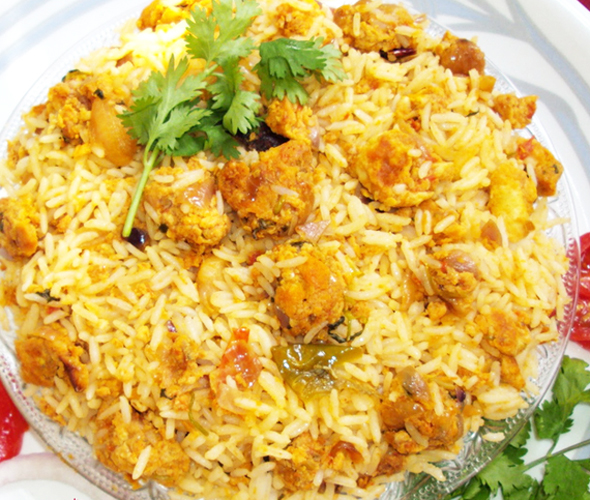Mama’s Punjabi Recipes: Wadiyan Da Pulao (Lentil Dumpling Rice Pilaf)
There are as many different ways to make pulao (rice pilaf) as there are cultures in the world. Each area’s pilaf dish one uses different types of ingredients, different spices and even different types of rice. Spanish people make a seafood paella; Arabs make a pulao using cuts of meat and the Chinese cook it as stir fried rice. The end result is the same: rice cooked together with some other ingredient to make a complete dish that can be eaten by itself.
Pulao is a Farsi word meaning rice stirred and other ingredients and cooked. This should not be confused with Biryani (also a Farsi word meaning “fry before cooking”) of which the Lucknow and Hyderabad variety are the most famous. For biryani, the meat is first fried, the rice is fried in oil and cooked half-way and then the rice and meat are layered in a handi (earthen pot) and cooked.
Wadiyan are one of the most Punjabi foods, and are basically sun dried balls of spiced ground lentils. They are aromatic and spicy, and when cooked with rice, add a flavor that is hidden inside the dumpling. Normally you don’t eat the whole wadi (which can be three inches in diameter when fully soaked), but eat small pieces of it with the rice, giving you bursts of flavor with each bite.
The best Punjabi wadiyan are made of skinless urad daal (black lentils) that is soaked overnight and then ground while still wet, with dhania (coriander), garam masala, lal mirch (red pepper), adrak (ginger) and hing (astafoetida powder) added. The sun dried wadiyan balls can be stored in the fridge for many months.
This recipe is for a pulao, but there is also a Punjabi dish (which I have already given) made in a similar way but for rice and wadiyan curry which is a meal by itself. Although vegetable or peas pulao can be found in many places, wadiyan pulao is not commonly available, so it is a real treat. For best results, make it in a wide brimmed kadai (wok).
Ingredients :
1 cup chawal (rice)
2 large size Punjabi wadiyan (sun dried lentil dumpling) or 4 medium ones
1 medium piyaaz (onion) – peeled and finely chopped
2 tablespoons tael (vegetable or olive oil)
2 cups of water (3 cups if using brown rice)
Spices (to taste): namak (salt), mirch (red pepper), jeera (cumin seed); dalchinni (cinnamon sticks broken into smaller pieces)Tomato paste to taste
Directions:
1.Soak the rice for 15 minutes in cold water and keep to the side.
2.Break the wadiyan into slightly 4 or 5 smaller pieces and keep to the side.
3.In the kadai, heat 2 tablespoons of oil and throw in the wadiyan and stir till they are slightly brown, stirring often so that they don’t burn. Take the wadiyan out and keep to the side.
4.In the kadai, throw in the jeera and chopped onions and stir till they are slightly brown and give off a nice aroma.
5.Drain the water from the rice. Add the rice to the kadai, salt and cinnamon pieces and stir to mix well. Add 2 cups of water, cover the kadai and let it the ingredients boil for 5 minutes over medium heat. After the first boil, throw in the wadiyan; no need to stir.
6.Turn the heat to low and cook for 10 minutes. Uncover the pot and check that the wadiyan have become plump and their aroma fills the pot. The dish is ready to eat with other vegetables, curries or by itself with yogurt.
MAMA’S TIP OF THE WEEK
KEEP LENTILS IN THE FRIDGE FOR LONG STORAGE
Many people will buy several large bags of daal (lentils) when they find them on sale and store them in their pantry in a covered can or sealed jar for a long time till they need to use the daal to cook. They are often disappointed and shocked to that a few months later, the whole daals – not the split ones – have small insects or larvae in them. That is because these insects thrive in warm, dark areas and slowly grow and multiply.
If you frequently eat daal and consume enough of it to quickly finish the amount in the store, there is a better way to store the unused quantities of whole daals. The best place to store whole daals and beans of all sorts is in the crisper section of the refrigerator where the cool temperature inhibits the growth of any larvae. The will stay clean and insect free for months.
Shakuntla Malhotra is a skilled cook of Punjabi dishes made in the old-fashioned style that she learnt as a young woman in her ancestral home in Lyallpur, India before it became part of Pakistan after the Partition in 1947. People have often admired her cooking for its simplicity and taste that comes with each mouthful. Even in her mid-eighties, she continues to cook daily and agreed to share some of her delectable Punjabi recipes.


